What’s Up With Our Watershed?
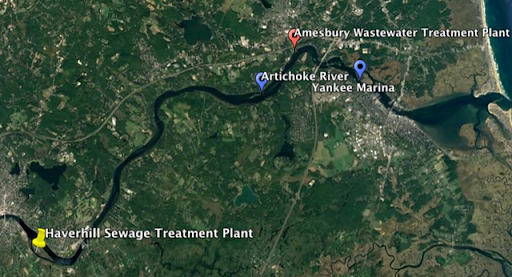
Photo Source: Kelley Conway
June 8, 2023
What is a watershed?
A watershed is an area of land that transports runoff into a body of water. Merrimac, Groveland, and West Newbury are all part of the 5,010-square-foot watershed that houses the Merrimack River. The river begins at the confluence of the Pemigewasset and Winnipesaukee Rivers in Franklin New Hampshire, and it flows south for 116 miles through Newburyport and empties into the Gulf of Maine. The Merrimack River is the fourth largest river in New England.
The Merrimack River is a recreational resource for more than 2.6 million people and is the primary drinking source for nearly 550,000 people. The watershed provides habitats to many sensitive species, but the water quality is being decreased by land development, CSOs, and pollution.
CSOs, or combined sewage overflows are a result of combined sewer systems collecting rainwater runoff, domestic sewage, and industrial wastewater into one pipe and exceeding the capacity of the system. The system often exceeds capacity after a storm when there is a surplus of water and run off. This means that instead of taking the water to a treatment facility the untreated stormwater and wastewater flows into nearby bodies of water, which in this area means the Merrimack River. CSOs are a main source of the Merrimack River’s pollution, but unfortunately there are no imminent solutions to fix CSOs.
Currently the Clean Water Act prohibits anyone from disposing of pollutants into a “United States water source” without having a National Pollution Discharge Elimination Systems permit. This permit effectively helps to reduce the amount of pollutants going into the Merrimack as it is one of the most threatened waterways. There are steps being taken to help increase the water quality of the Merrimack River, but very few people are aware of the importance of them being implemented.
Riparian Zones
The riparian zone of a watershed is just as important as the source of water itself. A riparian zone is the area of land that occurs along bodies of water. Its soil and vegetation is influenced by the presence of water, and it can support a high density of plants and animals. A healthy riparian zone filled with various forms of vegetation is important because it can help remove excess sediment from surface runoff, stabilize stream banks, and reduce flood water velocity. As a result, riparian zones are essential for improving water quality.
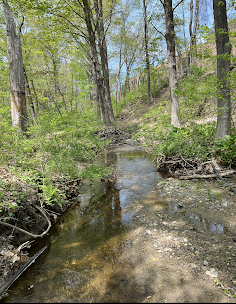
What are the different types of species that impact our watershed?
A native species is an organism that lives in the region where it first evolved. Native plants and animals are important to our watershed because they help maintain a balanced ecosystem. Without native species, the Merrimack River Watershed would collapse.
Native Plants: cattails, mullberries, balsam poplar, sensitive fern, speckled alder
Native Animals: river otter, snapping turtle, beaver, spring peeper, brook trout, common loon, freshwater mussels, atlantic sturgeon (endangered), atlantic salmon, American eel, bald eagle
Native insects: dobsonfly, leech, mayfly
Right now, native plants in the riparian zone are being threatened by invasive species, one of which is Japanese knotweed. Japanese knotweed is invasive because it grows uncontrollably. It doesn’t get eaten by insects, and it overcrowds other plants. This is a big problem for native plants because they aren’t getting the sunlight that they need. Invasive species are dangerous because there are no limiting factors that balance out their growth. Some current species that are posing a threat to the Merrimack River watershed are hydrilla, variable milfoil, curly-leaf pondweed, purple loosestrife, and water chestnut.
Conservation groups have spent billions of dollars trying to control invasive species. They have enacted Objective VGN-1 and GOAL 13.
In order to maintain a healthy watershed, we should promote the welfare of our native species.
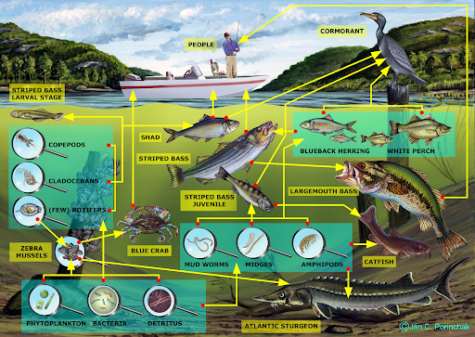
How do we measure sustainability?
In our Freshwater Ecology class, we made leaf packs for our campus stream. After the leaf packs were submerged in water for about a week, we brought them back into our classroom to record the number of macroinvertebrates that we saw. The next thing we did was classify these organisms into three different taxa groups. Then, we calculated how tolerant our stream was by using a biotic index data sheet. To conclude our experiment, we calculated a pollution tolerance index (PTI) score of 11 and determined that our stream is fairly tolerant to change.
We also went outside to record the temperature, nitrates, and pH of our stream.
What else can we do to keep the Merrimack River clean?
In order to keep our watershed healthy, we need to take small steps in the right direction.
Properly disposing of waste and choosing to recycle plastic is a great start. By doing this, it will decrease the amount of pollution that enters our stream and flows into the river. It will keep animals safe and reduce the amount of chemicals that are released into the ecosystem. Another way we could help our watershed is by restoring native plant species. We should also try to limit the amount of water we use during rainstorms to prevent CSOs.
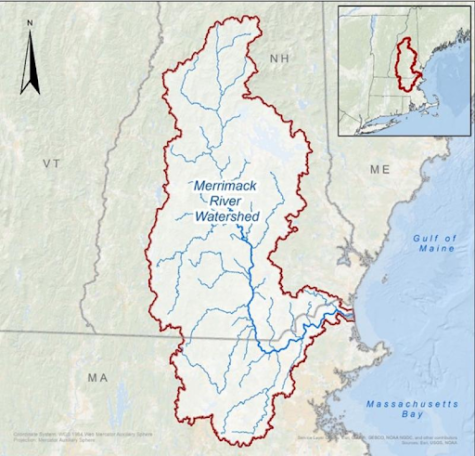
Another way to keep our watershed healthy is by engaging in local stream cleanups. This past week, Leah and I collected trash in the riparian zone of our campus stream. We found a lot of contaminants including plastic bottles, tennis balls, pencils, plastic bags, styrofoam, and food wrappers. By cleaning up our stream we stopped these pollutants from entering the river and flowing into the ocean.
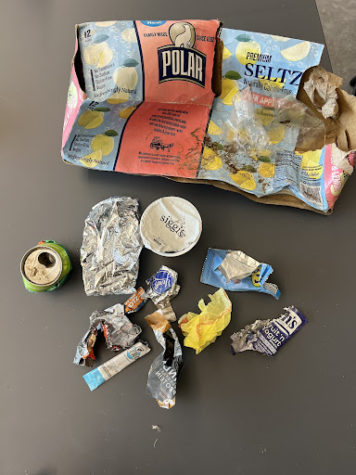
What do we think about our watershed?
We asked the question “What does the Merrimack River mean to you?”
Junior Alyssa Lare said, “It’s important to me because it provides water to a lot of people”. She hopes that, in the future, our river will be more clean and safe to swim in.
Junior Emily Jones said, “It reminds me of home because I’ve always been near the river”. She brings a reusable water bottle to school because she wants to decrease the amount of single-use plastic that gets thrown away.
When we asked junior Sawyer Pelletier what he thought about the river, he said, “It’s important to me because it’s really close to my house, and it affects the land a lot”. He agreed that we should recycle more plastic to protect the river.
When we asked people what their favorite native species is, a student said it was the bald eagle, and a teacher said it was the Atlantic sturgeon.
When we asked our Freshwater Ecology teacher, Mr. Soule, about the Merrimack River, he said, “The Merrimack River reminds me of history because I’ve lived near it my whole life. When I see it, I think of all the times I swam in it, boated on it, or fished in it. He said to make more environmentally friendly decisions we should cut down on how much water we use and what we put down the drain because eventually it ends up in our rivers”.










